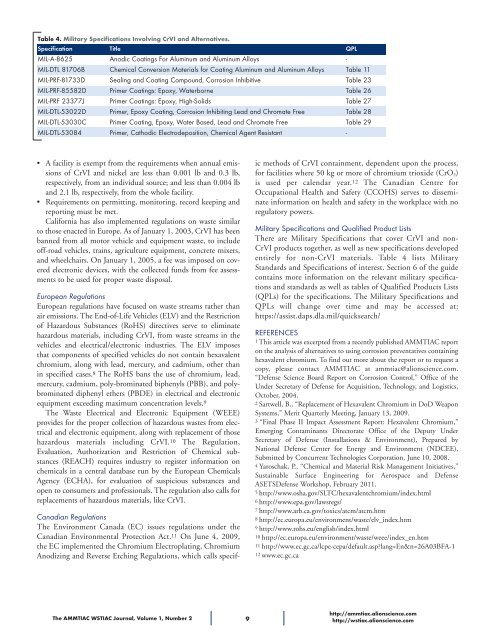AMMTIAC-WSTIAC Journal, Vol. 1, No. 2 - Advanced Materials ...
AMMTIAC-WSTIAC Journal, Vol. 1, No. 2 - Advanced Materials ...
AMMTIAC-WSTIAC Journal, Vol. 1, No. 2 - Advanced Materials ...
- No tags were found...
You also want an ePaper? Increase the reach of your titles
YUMPU automatically turns print PDFs into web optimized ePapers that Google loves.
Table 4. Military Specifications Involving CrVI and Alternatives.Specification Title QPLMIL-A-8625 Anodic Coatings For Aluminum and Aluminum Alloys -MIL-DTL 81706B Chemical Conversion <strong>Materials</strong> for Coating Aluminum and Aluminum Alloys Table 11MIL-PRF-81733D Sealing and Coating Compound, Corrosion Inhibitive Table 23MIL-PRF-85582D Primer Coatings: Epoxy, Waterborne Table 26MIL-PRF 23377J Primer Coatings: Epoxy, High-Solids Table 27MIL-DTL-53022D Primer, Epoxy Coating, Corrosion Inhibiting Lead and Chromate Free Table 28MIL-DTL-53030C Primer Coating, Epoxy, Water Based, Lead and Chromate Free Table 29MIL-DTL-53084 Primer, Cathodic Electrodeposition, Chemical Agent Resistant -• A facility is exempt from the requirements when annual emissionsof CrVI and nickel are less than 0.001 lb and 0.3 lb,respectively, from an individual source; and less than 0.004 lband 2.1 lb, respectively, from the whole facility.• Requirements on permitting, monitoring, record keeping andreporting must be met.California has also implemented regulations on waste similarto those enacted in Europe. As of January 1, 2003, CrVI has beenbanned from all motor vehicle and equipment waste, to includeoff-road vehicles, trains, agriculture equipment, concrete mixers,and wheelchairs. On January 1, 2005, a fee was imposed on coveredelectronic devices, with the collected funds from fee assessmentsto be used for proper waste disposal.European RegulationsEuropean regulations have focused on waste streams rather thanair emissions. The End-of-Life Vehicles (ELV) and the Restrictionof Hazardous Substances (RoHS) directives serve to eliminatehazardous materials, including CrVI, from waste streams in thevehicles and electrical/electronic industries. The ELV imposesthat components of specified vehicles do not contain hexavalentchromium, along with lead, mercury, and cadmium, other thanin specified cases. 8 The RoHS bans the use of chromium, lead,mercury, cadmium, poly-brominated biphenyls (PBB), and polybrominateddiphenyl ethers (PBDE) in electrical and electronicequipment exceeding maximum concentration levels. 9The Waste Electrical and Electronic Equipment (WEEE)provides for the proper collection of hazardous wastes from electricaland electronic equipment, along with replacement of thosehazardous materials including CrVI. 10 The Regulation,Evaluation, Authorization and Restriction of Chemical substances(REACH) requires industry to register information onchemicals in a central database run by the European ChemicalsAgency (ECHA), for evaluation of suspicious substances andopen to consumers and professionals. The regulation also calls forreplacements of hazardous materials, like CrVI.Canadian RegulationsThe Environment Canada (EC) issues regulations under theCanadian Environmental Protection Act. 11 On June 4, 2009,the EC implemented the Chromium Electroplating, ChromiumAnodizing and Reverse Etching Regulations, which calls specificmethods of CrVI containment, dependent upon the process,for facilities where 50 kg or more of chromium trioxide (CrO 3)is used per calendar year. 12 The Canadian Centre forOccupational Health and Safety (CCOHS) serves to disseminateinformation on health and safety in the workplace with noregulatory powers.Military Specifications and Qualified Product ListsThere are Military Specifications that cover CrVI and non-CrVI products together, as well as new specifications developedentirely for non-CrVI materials. Table 4 lists MilitaryStandards and Specifications of interest. Section 6 of the guidecontains more information on the relevant military specificationsand standards as well as tables of Qualified Products Lists(QPLs) for the specifications. The Military Specifications andQPLs will change over time and may be accessed at:https://assist.daps.dla.mil/quicksearch/REFERENCES1 This article was excerpted from a recently published <strong>AMMTIAC</strong> reporton the analysis of alternatives to using corrosion preventatives containinghexavalent chromium. To find out more about the report or to request acopy, please contact <strong>AMMTIAC</strong> at ammtiac@alionscience.com.“Defense Science Board Report on Corrosion Control,” Office of theUnder Secretary of Defense for Acquisition, Technology, and Logistics,October, 2004.2 Sartwell, B., “Replacement of Hexavalent Chromium in DoD WeaponSystems,” Merit Quarterly Meeting, January 13, 2009.3 “Final Phase II Impact Assessment Report: Hexavalent Chromium,”Emerging Contaminants Directorate Office of the Deputy UnderSecretary of Defense (Installations & Environment), Prepared byNational Defense Center for Energy and Environment (NDCEE),Submitted by Concurrent Technologies Corporation, June 10, 2008.4 Yaroschak, P., “Chemical and Material Risk Management Initiatives,”Sustainable Surface Engineering for Aerospace and DefenseASETSDefense Workshop, February 2011.5 http://www.osha.gov/SLTC/hexavalentchromium/index.html6 http://www.epa.gov/lawsregs/7 http://www.arb.ca.gov/toxics/atcm/atcm.htm8 http://ec.europa.eu/environment/waste/elv_index.htm9 http://www.rohs.eu/english/index.html10 http://ec.europa.eu/environment/waste/weee/index_en.htm11 http://www.ec.gc.ca/lcpe-cepa/default.asp?lang=En&n=26A03BFA-112 www.ec.gc.caThe <strong>AMMTIAC</strong> <strong>WSTIAC</strong> <strong>Journal</strong>, <strong>Vol</strong>ume 1, Number 2 9http://ammtiac.alionscience.comhttp://wstiac.alionscience.com
















